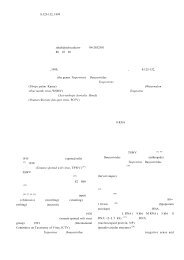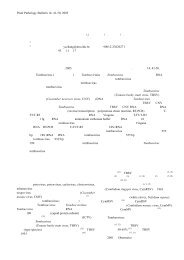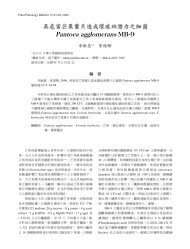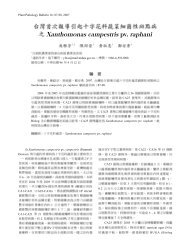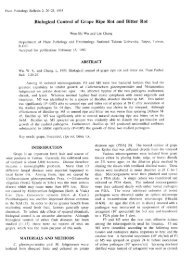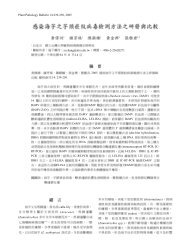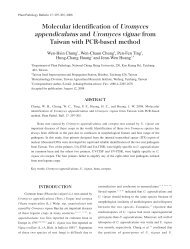Botryosphaeria rhodina
Botryosphaeria rhodina
Botryosphaeria rhodina
Create successful ePaper yourself
Turn your PDF publications into a flip-book with our unique Google optimized e-Paper software.
22215 4 2006A. B. C.D. E. F. G & H.I.Fig 1. Diseases symptoms of stem canker of guava. A. Severely decline symptom on guava. B. Linear cankers on trunkand branches caused separation of the bark strips. C. Blight symptom of branchlet. D. Longitudinal bark crack onbranchlet. E. Brown pith in section of branchlet. F. Blight symptom of an inoculated shoot. G & H. Elongate canker andlongitudinal bark crack respectively developed on branches after inoculations on branchlets. I. Brown pith in section of aninoculated branch.
22415 4 2006A. B. ( )C. D-G. H. I.BR-10Fig 2. Morphology of the pathogen, <strong>Botryosphaeria</strong> <strong>rhodina</strong>, causing stem canker of guava. A. Ascoma produced on barkin the field. B. Spermogonium (arrow) was associated with ascoma on bark in the field. C. Ascus and ascospores. D-G.Conidia and paraphyses derived from monoascospore in cultures. H. Spermogonium and spermatia produced on bark in thefield. I. Conidia and spermatia produced in cultures of BR-10 isolate derived from monoascospore. Scale bars: A & B =100 m; C-I = 10 m.
<strong>Botryosphaeria</strong> <strong>rhodina</strong> 225Table 2. Survey on the occurrence of stem canker of guava in main production areas in Taiwan.Age of Plants No. of Disease Plants/ No. of Surveyed 1 Plants Range of MeanLocation(year) orchard 1 orchard 2 orchard 3 orchard 4 frequency (%) (%)KaohsiungDasheYanchaoGangshanTainanHoubiYujingChanghuaShetou1Sijhou0-2 5/146 6/136 35/284 3.42-12.32 8.132-4 3/200 4/407 7/155 0.98-4.51 1.844-6 35/95 28/154 0/200 0-36.84 14.030-2 38/113 23/228 69/233 10.09-33.63 22.652-4 5/43 21/113 25/200 11.63-18.58 14.334-6 35/100 52/151 59/220 26.82-35.00 31.000-2 11/55 34/247 16/165 9.67-20.00 13.062-4 20/150 45/168 102/104 87/144 13.33-98.08 44.884-6 25/107 18/61 27/213 12.68-29.51 18.370-2 10/172 55/136 2/276 0.72-40.44 11.472-4 227/322 16/325 3/243 1.23-70.50 27.644-6 1/208 5/162 35/197 0.48-17.77 7.230-2 43/80 1/153 0/88 0/235 0-53.75 7.912-4 2/79 96/200 46/191 2.53-48.00 30.644-6 2/134 44/219 19/54 0/259 0-35.19 9.760-2 6/155 51/164 1/61 0/74 0-31.10 12.782-4 0/175 0/286 0/272 0 04-6 0/62 0/235 0/68 0 00-2 7/103 11/172 8/124 6/273 2.20-6.80 4.762-4 0/294 0/186 0/321 0 04-6 0/282 0/162 0/113 0 0The diseased plants were judged by the linear cankers, the typical symptom, appearing on the trunks.<strong>Botryosphaeria</strong> <strong>rhodina</strong>Table 3. Pathogenicity tests of <strong>Botryosphaeria</strong> <strong>rhodina</strong> on various species and cultivars of guava and ftruit treesSpecies and cultivarsNo. of blight / no. of No. of blight / no. of Mean of blightedinoculated with BR-01 1 inoculated with BR-11 shoots (%)Psidium guajava L.Seedless guava ( ) 3/5 4/5 70Huang-jin Ba ( ) 4/5 4/5 80Fen Ba ( ) 4/5 4/5 80Malaysia seedless guava( )4/5 4/5 80Zhong-shan-yue Ba ( ) 4/5 5/5 90Shui-jing Ba ( ) 4/5 5/5 90Tai-guo Ba ( ) 5/5 4/5 90Round leaf seedless guava ( ) 4/5 5/5 90Da-di-zai ( ) 5/5 4/5 90Zhen-zhu Ba ( ) 5/5 5/5 100Shui-mi seedless Ba ( ) 5/5 5/5 100
22615 4 2006<strong>Botryosphaeria</strong> <strong>rhodina</strong> ( )Table 3. Pathogenicity tests of <strong>Botryosphaeria</strong> <strong>rhodina</strong> on various species and cultivars of guava and ftruit trees (con.)Species and cultivarsNo. of blight / no. of No. of blight / no. of Mean of blightedinoculated with BR-01 1 inoculated with BR-11 shoots (%)Psidium guajava L.Er-sh-sh-ji Ba ( ) 5/5 5/5 100Xiang Ba ( ) 5/5 5/5 100Li-zai Ba ( ) 5/5 5/5 10066-90 5/5 5/5 100Bai Ba ( ) 5/5 5/5 100Tainung No.1. ( ) 5/5 5/5 100Psidium cattleianum SabineStrawberry guava ( ) 4/5 5/5 90Psidium spp.Jhen-jhu Ba ( ) 3/5 4/5 70Mauritius guava ( ) 0/5 0/5 0Annona cherimola Mill. A. squamosa L.Atemoya ( ) 0/5, 0/5 0/5, 0/5 0Carica papaya L.Tainung No.2. ( ) 5/5 4/5 90Dimocarpus longan Lour.Fen-ke ( ) 0/5, 0/5 0/5, 0/5 0Litchi chinensis Sonn.Yu-he-bao ( ) 0/4, 0/5 0/4, 0/5 0Mangifera indica L.Irwin ( ) 0/5, 0/5 0/5, 0/5 0Syzygium samarangense (Blume) Merr. &L.M. PerryNan-yang variety ( ) 2/4 2/4 50Zizyphus mauritiana Lam.Mi-zao ( ) 3/4 3/4 751The pathogenicity tests were carried out by inoculation of the pathogens, BR-01and BR-11, on the unlignified shoots of all plants.Lasiodiplodia theobromaeTable 4. Pathogenicity of Lasiodiplodia theobromae isolated from other fruit trees to guava shootsIsolate 1 Location HostSymptom on No. of blighted shoots/ Rateoriginal host No. of inoculated shoots 2 ( )LaPa-1 Linluo, Pingtung Carica papaya Fruit rot 4/4 100LaPa-2 Meinong, Kaohsiung C. papaya Fruit rot 4/4 100LaMa-1 Fongshan, Kaohsiung Mangifera indica Leaf blight 0/4 0LaMa-3 Fongshan, Kaohsiung M. indica Fruit rot 0/4 0LaJu-1 Dashe, Kaohsiung Zizyphus mauritiana Fruit rot 0/4 0LaJu-2 Dashe, Kaohsiung Z. mauritiana Fruit rot 3/4 75LaWa-1 Chaojhou, Pingtung Syzygium samarangense Fruit rot 4/4 100BRWa-1 Yanchao, Kaohsiung S. samarangense Branchlet blight 1/4 25BR-01 Dashe, Kaohsiung Psidium guajava Pith brown 4/4 100BR-11 Dashe, Kaohsiung P. guajava Trunk canker 4/4 100CK 0/4 012According to the morphologic characters, all isolates were identified as Lasiodiplodia theobromae.Isolates were inoculated on unlignified shoots of Zhen-zhu Ba to test their pathogenicity.
<strong>Botryosphaeria</strong> <strong>rhodina</strong> 229oxysporum f. sp. psidii as a pathogen causing wilt ofguava in Varanasi District, India. Phytopathol. Z. 114:243-248.17. Pennycook, S. R., and Samuels, G. J. 1985.<strong>Botryosphaeria</strong> and Fusicoccum species associatedwith ripe fruit rot of Actinidia deliciosa (kiwifruit) inNew Zealand. Mycotaxon 24: 445-458.18. Phillips, A. J. L. 2000. <strong>Botryosphaeria</strong> populi sp. nov.and its Fusicoccum anamorph from poplar trees inPortugal. Mycotaxon 74: 135-140.19. Phillips, A. J. L., Fonseca, F., Povoa, V., Castilho, R.,and Nolasco, G. 2002. A reassessment of theanamorphic fungus Fusicoccum luteum anddescription of its teleomorph <strong>Botryosphaeria</strong> lutea sp.nov. Sydowia 54: 59-77.20. Ploetz, R. C. 2003. Diseases of Mango. Pages 327-364. in: Diseases of tropical fruit crops. R. C. Ploetzed. CAB International, Wallingford, UK, 305pp.21. Ploetz, R. C., Benscher, D., V zquez, A., Colls, A.,Nagel, J., and Schaffer, B. 1996. A reexamination ofmango decline in Florida. Plant Dis. 80: 664-668.22. Prasad, N., Mehta, P. R. and Lal, S. B. 1952. Fusariumwilt of guava in Uttar Pradesh, India. Nature (London)169: 753.23. Punithalingam, E. 1976. Botryodiplodia theobromae.CMI Descriptions of Pathogenic Fungi and BacteriaNo. 519. Commonwealth Mycological Institute, Kew,UK.24. Salzedas, L. F., and Netto Rodrigues, S. M. 1985.Occurrence of guava canker caused by <strong>Botryosphaeria</strong>dothidea in the region of Ara atuba, State of S oPaulo, Brazil. Biol gico 51: 295-297. (in Portuguesewith English abstract)25. Schroers, H.-J., Geldenhuis, M. M., Wingfield, M. J.,Schoeman, M. H., Yen, Y. F., Shen, W. C., andWingfield, B. D. 2005. Classification of the guava wiltfungus Myxosporium psidii, the palm pathogenGliocladium vermoesenii and the persimmon wiltfungus Acremonium diospyri in Nalanthamala.Mycologia 97: 375-395.26. Sivanesan, A. 1984. The bitunicate Ascomycetes andtheir anamorphs. J. Cramer. Vaduz, Germany, 701pp.27. Slippers, B., Crous, P. W., Denman, S., Coutinho, T.A., Wingfield, B. D., and Wingfield, M. J. 2004.Combined multiple gene genealogies and phenotypiccharacters differentiate several species previouslyidentified as <strong>Botryosphaeria</strong> dothidea. Mycologia 96:83-101.28. Slippers, B., Johnson, G. J., Crous, P. W., Coutinho, T.A., Wingfield, B. D., and Wingfield, M. J. 2005.Phylogenetic and morphological re-evaluation of the<strong>Botryosphaeria</strong> species causing diseases of Mangiferaindica. Mycologia 97: 99-110.29. Subileau, C., Renard, J. L., and Lacoste, L. 1994.<strong>Botryosphaeria</strong> cocogena nov. sp. agent causal dudess chement foliaire du cocotier au Br sil.Mycotaxon 51: 5-14. (in French with English abstract)30. Sun, S. K. 1996. Diseases of Fruit Trees in Taiwan.Shi-Wei press, Taichung, Taiwan, 427pp. (in Chinese).31. Sutton, B.C. 1980. The Coelomycetes. CommonwealthMycological Institute, Kew, UK. 696 pp.32. Tsai, P. L. 1997. Aroma within My Memory . HarvestFarm Magazine press, Taipei, Taiwan, R.O.C. 131 pp.(in Chinese)33. Tsay, J. G., Tung, B. K., and Kuo, C. H. 1992. Theoptimum temperature for disease development and thesusceptibility to fungicides for fruit rot fungi of guava.Plant Prot. Bull. 34: 351-352. (in Chinese)34. Uduebo, A. E. 1975. Fine structural studies on thepycnidiosores of Botryodiplodia theobromae Pat. Ann.Bot. 39: 605-610.35. Wang, C. L., Hsieh, H. Y., and Lee, W. L. 2004.Identification of the stem canker of Psidium guajavaL. Plant Pathol. Bull. 13: 342. (in Chinese)36. Weber, G. F. 1970. Bacteria and Fungal Diseases ofPlants in the tropics. University of Florida Press,Gainesville, USA, 673 pp.
23015 4 2006ABSTRACTWang, C. L. 1, 3 , and Hsieh, H. Y. 22006. Occurrence and pathogenicity of stem canker of guava inTaiwan caused by <strong>Botryosphaeria</strong> <strong>rhodina</strong>. Plant Pathol. Bull. 15:219-230. ( 1 Department of PlantProtection and 2 Department of Tropical Fruit, Fengshan Tropical Horticultural Experiment Station,Agricultural Research Institute, Council of Agriculture, Executive Yuan, Fongshan, Kaohsiung,Taiwan; 3 Corresponding author. E-mail: chihli@fthes-tari.gov.tw; Fax: +886-7-7315590)The fungal pathogen <strong>Botryosphaeria</strong> <strong>rhodina</strong> has been identified as the causal agent of a guava(Psidium guajava L.) stem canker in Taiwan. According to a 3-year survey during 2003 to 2005, thestem canker was commonly found in guava orchards of Kaohsiung, Tainan, and Changhua Counties.Symptoms of the stem canker including linear cankers with bark cracks on the trunks and branches ofguava tree were found on diseased plants. A brown discoloration was showed in the infected areas ofcambiums and xylem, extending to the pith tissues. The cankers on the branchlets and separation ofthe bark strips on the branches and trunks resulted in retarding guava’s growth, leaf wilting, andprogressive death. The same disease symptoms were observed in a guava cultivar ‘Zhen-zhu Ba’through artificial inoculation of wounded tissues with mycelial agar discs. The ten isolates derivedfrom either infected tissues or ascospores collected from three different geographic locations inKaohsiung were used for morphological studies. Sexual stages of pathogen isolated from infectedtissues were identified as B. <strong>rhodina</strong>. Spermogonia (160-220 110-140 m), suboblate to conical inshape, with hyaline, rod-like spermatia (2.5-4 1-1.5 m) were observed in the BR-10 isolate andthe infected canker tissue. All isolates produced asexual spores of Lasiodiplodia theobromae on wateragar medium with a piece of guava leaf under near-UV light. Two isolates, BR-01 and BR-11, wereused for inoculation tests on 17 guava cultivars, strawberry guava, Jhen-jhu Ba, Mauritius guava and7 tropical fruits, including atemoya, Indian jujube, lychee, longan, mango, papaya and wax apple. Theresults indicated that Mauritius guava and 4 tropical fruits (lychee, longan, mango and atemoya) wereresistant to the pathogen. However, guava was resistant to two isolates of mango and one of Indianjujube. It showed that different pathotypes presented in B. <strong>rhodina</strong>. In addition, the results that L.theobromae was readily isolated from graft unions of blighted seedlings, dry fruit stalks, and blightedshoots might imply the possible infection sites of pathogen.Key words: guava, stem canker, <strong>Botryosphaeria</strong> <strong>rhodina</strong>, Lasiodiplodia theobromae, pathogenicity



